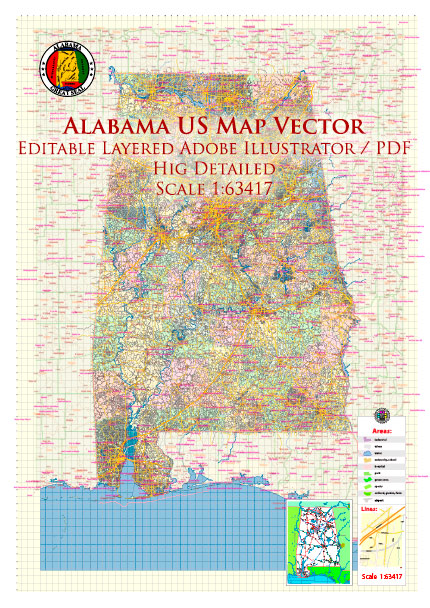Geography of Alabama
The geography of Alabama describes a state in the Southeastern United States in North America.
It extends from high mountains to low valleys and sandy beaches. Alabama is 30th in size and borders
four U.S. states: Mississippi, Tennessee, Georgia, and Florida. It also borders the Gulf of Mexico.
Extending entirely across the state of Alabama for about 20 miles (32 km) northern boundary, and in the middle stretching
60 miles (97 km) farther north, is the Cumberland Plateau, or Tennessee Valley region, broken into broad tablelands
by the dissection of rivers. In the northern part of this plateau, west of Jackson county, there are
about 1,000 square miles (2,600 km2) of level highlands from 700 to 800 feet (210 to 240 m) above sea level.
South of these highlands, occupying a narrow strip on each side of the Tennessee River, is a country of
gentle rolling lowlands varying in elevation from 500 to 800 feet (150 to 240 m). To the northeast of these
highlands and lowlands is a rugged section with steep mountain-sides, deep narrow coves and valleys,
and flat mountain-tops. Its elevations range from 400 to 1,800 feet (120 to 550 m). In the remainder of this region,
the southern portion, the most prominent feature is Little Mountain, extending about 80 miles (129 km)
from east to west between two valleys, and rising precipitously on the north side 500 feet (150 m)
above them or 1,000 feet (300 m) above the sea.
Adjoining the Cumberland Plateau region on the southeast is the Appalachian Valley (locally known as Coosa Valley)
region, which is the southern extremity of the Appalachian Mountains, and occupies an area within the state
of about 8,000 square miles (21,000 km2). This is a limestone belt with parallel hard rock ridges left standing
by erosion to form mountains. Although the general direction of the mountains, ridges, and valleys is
northeast and southwest, irregularity is one of the most prominent characteristics. In the northeast are
several flat-topped mountains, of which Raccoon and Lookout are the most prominent, having a maximum
elevation near the Georgia line of little more than 1,800 feet (550 m) and gradually decreasing in height
toward the southwest, where Sand Mountain is a continuation of Raccoon. South of these the mountains are
marked by steep northwest sides, sharp crests and gently sloping southeast sides.
Southeast of the Appalachian Valley region, the Piedmont Plateau also crosses the Alabama border from the N.E.
and occupies a small triangular-shaped section of which Randolph and Clay counties, together with the northern
part of Tallapoosa and Chambers, form the principal portion. Its surface is gently undulating and has an elevation
of about 1,000 feet (300 m) above sea level. The Piedmont Plateau is a lowland worn down by erosion on hard
crystalline rocks, then uplifted to form a plateau.
The remainder of the state is occupied by the Coastal Plain. This is crossed by foothills and rolling prairies
in the central part of the state, where it has a mean elevation of about 600 feet (180 m), becomes lower and
more level toward the southwest, and in the extreme south is flat and but slightly elevated above the sea.
The Cumberland Plateau region is drained to the west-northwest by the Tennessee River and its tributaries;
all other parts of the state are drained to the southwest. In the Appalachian Valley region the Coosa River
is the principal river; and in the Piedmont Plateau, the Tallapoosa River. In the Coastal Plain are the
Tombigbee River in the west, the Alabama River (formed by the Coosa and Tallapoosa) in the western central,
and in the east the Chattahoochee River, which forms almost half of the Georgia boundary.
The Tombigbee and Alabama rivers unite near the southwest corner of the state, their waters discharging
into Mobile Bay by the Mobile and Tensas rivers. The Black Warrior River is a considerable stream which
joins the Tombigbee from the east.
The valleys in the north and northeast are usually deep and narrow, but in the Coastal Plain they are broad
and in most cases rise in three successive terraces above the stream. The harbour of Mobile was formed by
the drowning of the lower part of the valley of the Alabama and Tombigbee rivers as a result of the sinking
of the land here, such sinking having occurred on other parts of the Gulf coast.
Source: https://en.wikipedia.org/wiki/Geography_of_Alabama


 Author: Kirill Shrayber, Ph.D.
Author: Kirill Shrayber, Ph.D.